Robots for Defense, Space and Medicine: Inside Look Into Russian Robotics
17:50 GMT 08.06.2023 (Updated: 18:00 GMT 08.06.2023)
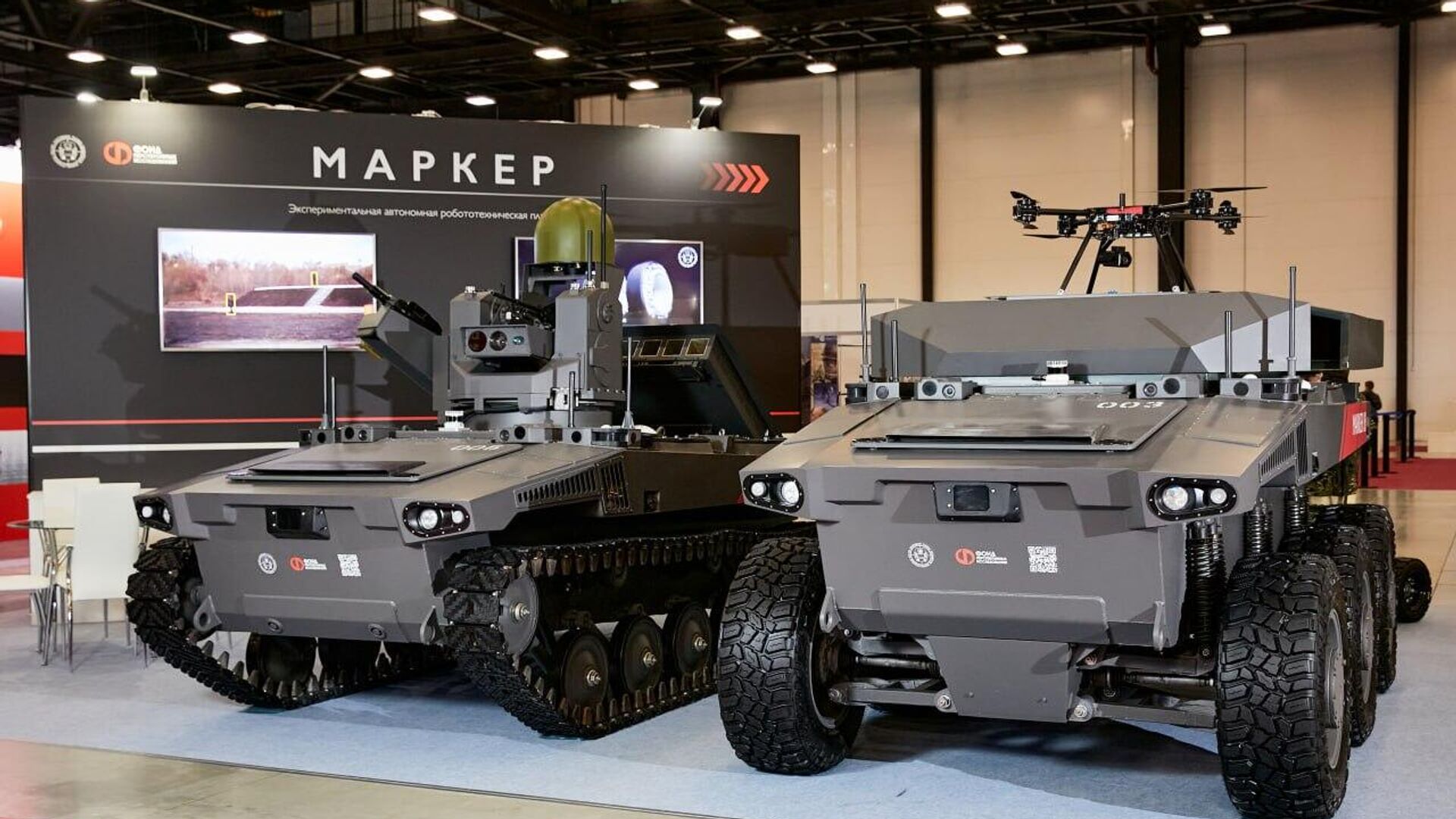
© Sputnik / Androidnaya Tekhnika
Subscribe
The Ukrainian security crisis has shown the importance of unmanned systems in modern warfare. Sputnik sat down with the director of one of Russia’s most ambitious robotics firms to learn more about the challenges and opportunities the country’s robotics pioneers face in designing and building robots for both military and civilian applications.
NATO has deployed some of its most advanced unmanned aerial vehicle (UAV) and anti-drone defense systems against Russia in Ukraine, with some Western media openly labeling the conflict a “testing ground” for new weapons, including drones. Russia, which initially lagged behind the Western alliance in military UAV technology, quickly caught up over the past year, ramping up the production of kamikaze drone designs, plus long-range reconnaissance UAVs which British military intelligence recently credited with the success of Russia’s deep missile strike campaigns against Ukrainian military infrastructure.
Marker Unmanned Combat Robots
Recent weeks have seen a flurry of reports in Russian media on a new ground-based unmanned system - the Marker combat robot platform. Capable of working autonomously at distances up to 10 km from its operator, the three-ton robotic complex can be equipped with a range of weaponry, from deadly Kornet Leopard 2-killing anti-tank missiles to swarms of BAS-80 kamikaze and target designation drones - which can fly up to 30 km from their host platform. Versions of the Marker with a 7.62 mm machinegun and AGS-17 and AGS-30 grenade launchers are also being tested.
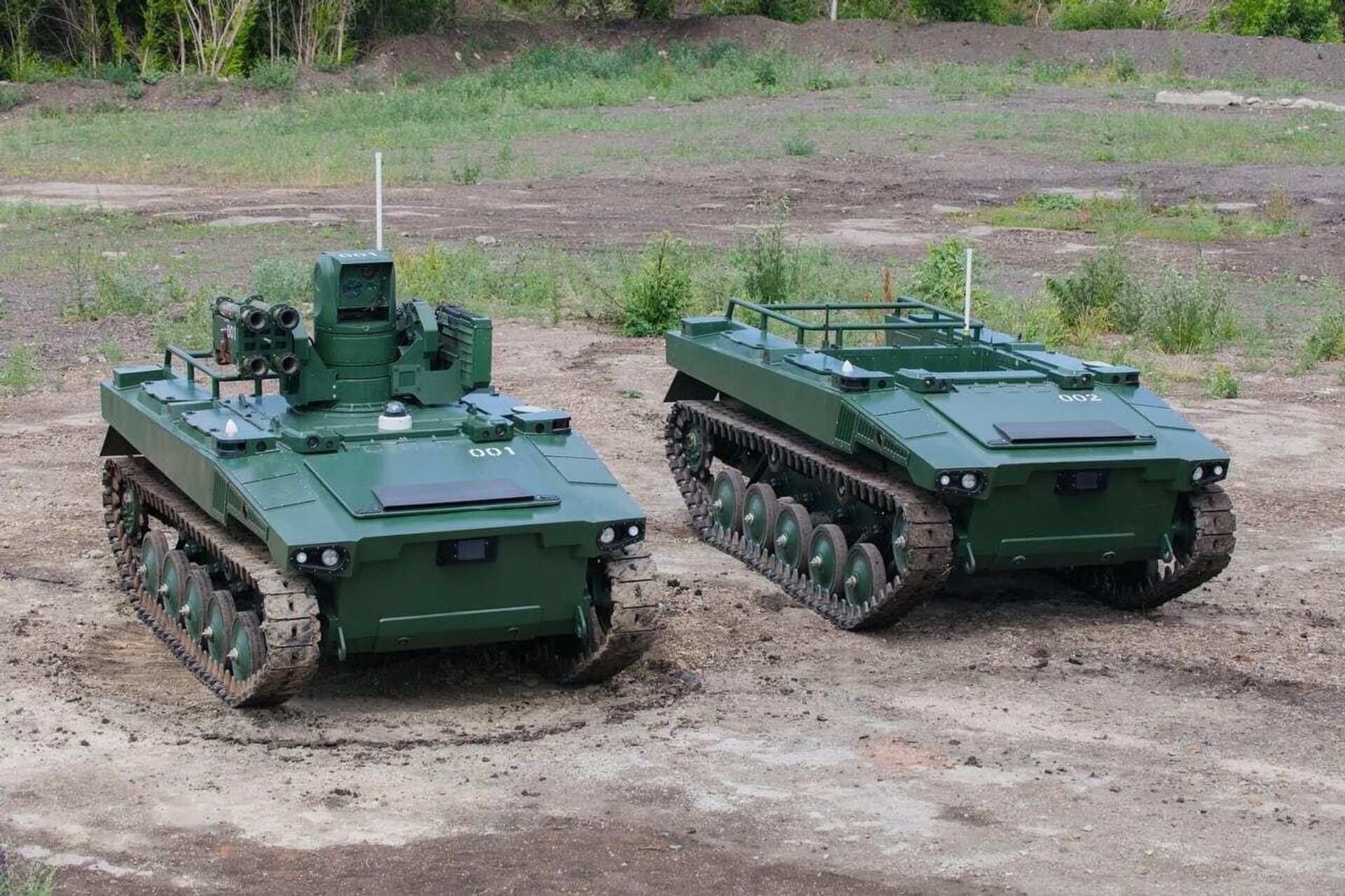
Marker robot ground vehicles showing off their modular characteristics, which provide for a variety of uses.
© Sputnik / Androidnaya Tekhnika
Markers feature a modular multispectral vision system, with data reportedly processed using neural network algorithms. Russian forces are expected to be trained to use these ground-based combat drones in the near future.
Russian developers are also working on another ground-based unmanned vehicle – a remote-controlled truck for use on the front lines to deliver ammunition and supplies, and to evacuate the wounded. Testing of a prototype of the system is underway.
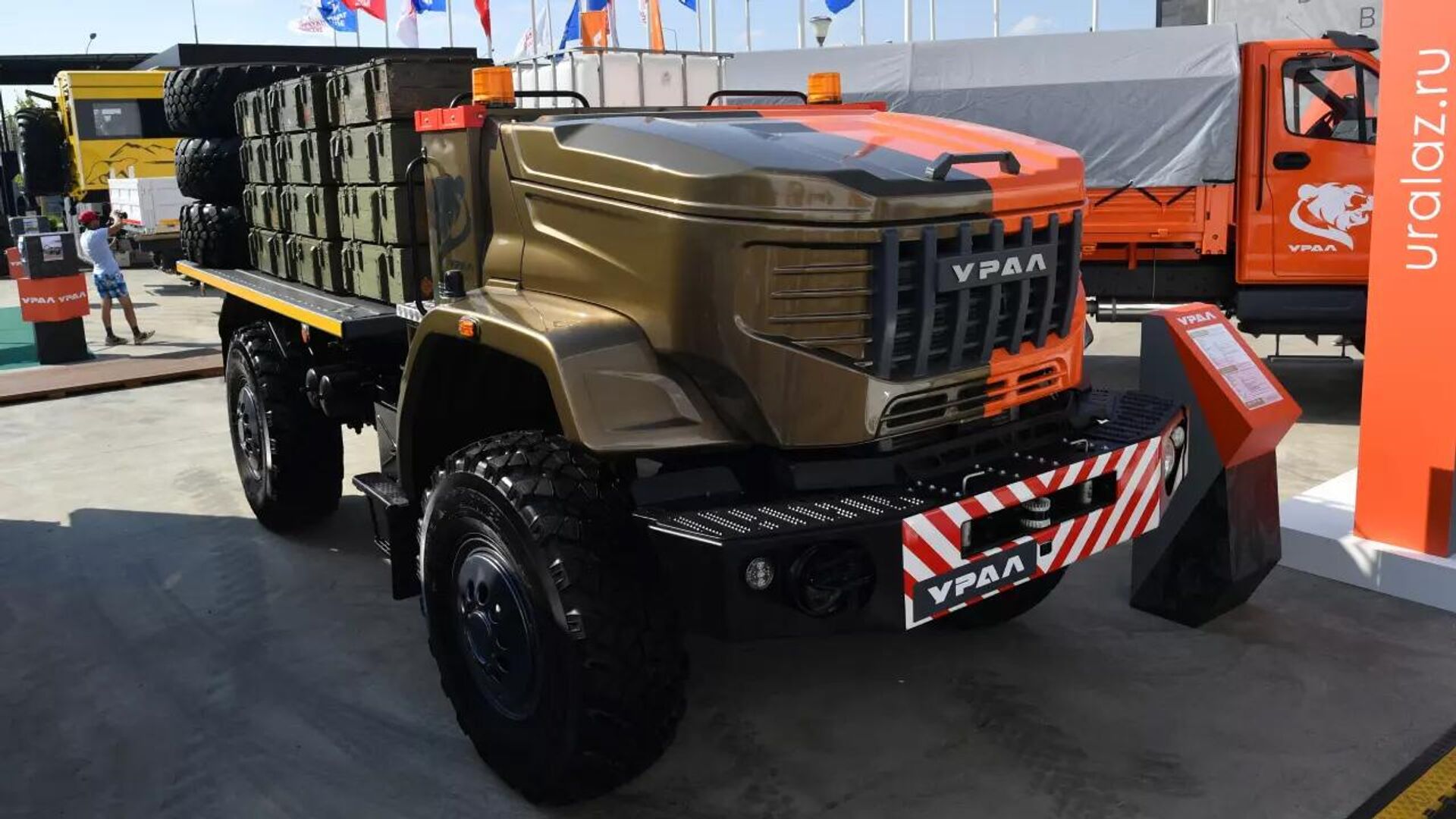
An unmanned Ural truck created by Androidnaya Tekhnika engineers at an exhibition.
© Sputnik / Androidnaya Tekhnika
Both projects are the brainchild of the Android Technics Scientific Production Association, a Magnitogorsk-headquartered research and production association probably best known for its ambitious FEDOR space robot project – which underwent a week’s worth of testing aboard the International Space Station in 2019.
Along with robots for the military and space exploration, the company has engaged in some more down to earth applications, such as robotic wheelchairs to assist in the social adaptation of people with disabilities, manipulator robot arms, medical systems designed to help restore locomotor system functions, and a line of modular AT and AX drive electric motors.
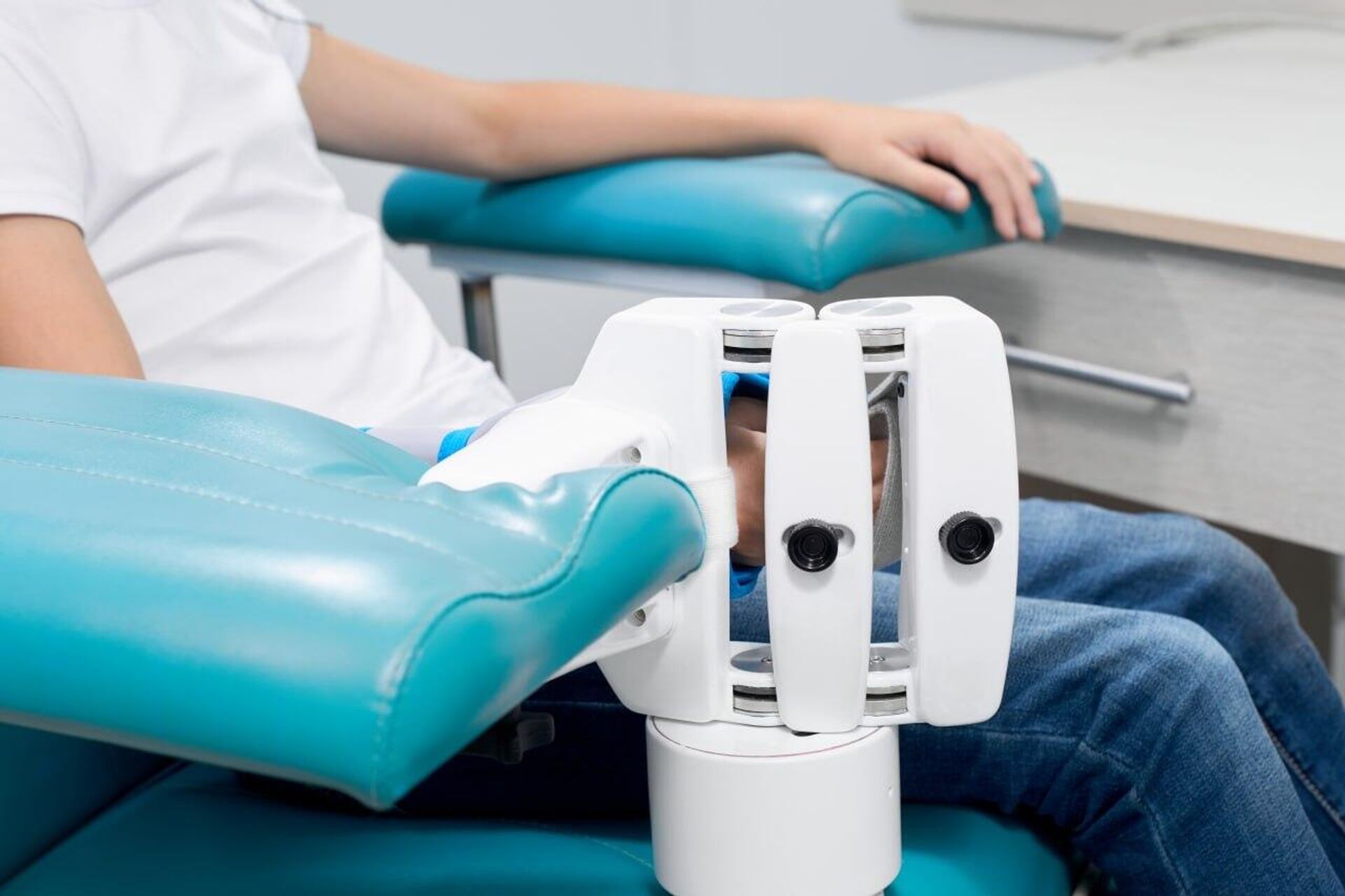
Ortez-1 - a robotic complex designed to assist with the restoration of the locomotor functions of the hands.
© Sputnik / Androidnaya Tekhnika
Yevgeny Dudorov is Android Technics' general director. Speaking exclusively with Sputnik in a broad-ranging interview discussing the challenges and opportunities of running a company specializing in advanced robotics in Russia, Dudorov explained what makes the company tick, plus his thoughts on what kind of shot in the arm the industry will need to really be able to take on the current world leaders.
“I would say that there are two main directions for progress. The first is humanity’s laziness – the desire to invent something new to work less, move less and receive more amenities. The second engine of progress is warfare, because both sides in a conflict attempt to resolve things in their favor, and immediately start to mobilize all those forces, all those ideas that they have – leading to a kind of permanent brainstorming effect. People begin to think things up, create, test, receive feedback, make adjustments and go through it all again,” Dudorov said.
Robotics for Defense
Pointing to the “zoo” of various unmanned aerial systems being used in Ukraine, Dudorov said that unmanned ground-based weapons platforms are also ripe for transformation into drones. “Of course, few have heard about their testing there. But basically, these are remotely-controlled systems with whose help it’s possible to deliver something or, on the contrary, assist in the evacuation of entire units,” he explained.
Among the prospective ground-based weapons systems is the Marker combat robot. “The Marker is a special platform with a set of payloads, consisting of a universal module on which various types of weapons can be installed, unmanned aerial vehicles can be launched, etc. The system [can play] a significant role in countering UAVs,” Dudorov said.
© Sputnik
The autonomous, AI-augmented weapons platform is equipped with optics which can detect the movement of ground and –air-based objects, train on them, accompany them and, if necessary, attack them. The company has already carried out a series of preliminary tests on the system’s effectiveness.
“The robot will operate autonomously, but under a person’s control. That is, the system will detect some object, receive information from a radar station, for example,” Dudorov explained. From there, Marker independently focuses on the target and processes its trajectory far more quickly and effectively than is possible by the human eye or brain. This system is not fully autonomous, however, requiring the go-ahead from a human operator to fire.
'Locomotive' Projects in the Civilian Sector
Android Technics has also created a range of civilian applications, including modular electric motors made of close to 100% domestically-sourced components for use in satellites, as well as the ‘Ortez’ and ‘Junior’ medical robotic complexes designed to assist in the rehabilitation of stroke victims, plus children with developmental disabilities like cerebral palsy.
“These are the two ‘locomotive’ projects which we’re now carrying out in terms of serial production. If we’re talking about our research and development work, here we also have several projects. One is the development of a robot for work outside the International Space Station. This project is called ‘Teledroid’. And possibly as soon as 2024-2025, depending on the flight program, the robot should be flown to the ISS and work outside the space station, carrying out useful functions which a cosmonaut could in principle perform, but serving as a kind of assistant,” Dudorov said.
The company has made international headlines in the past with its work with anthropomorphic avatar robots, designed for use in both the lifeless environments of outer space, and areas on Earth suffering from chemical or radioactive contamination. The goal is to create machines which can replace humans in especially dangerous work environments. Android Technics is working with Roscosmos and Rosatom in these directions.
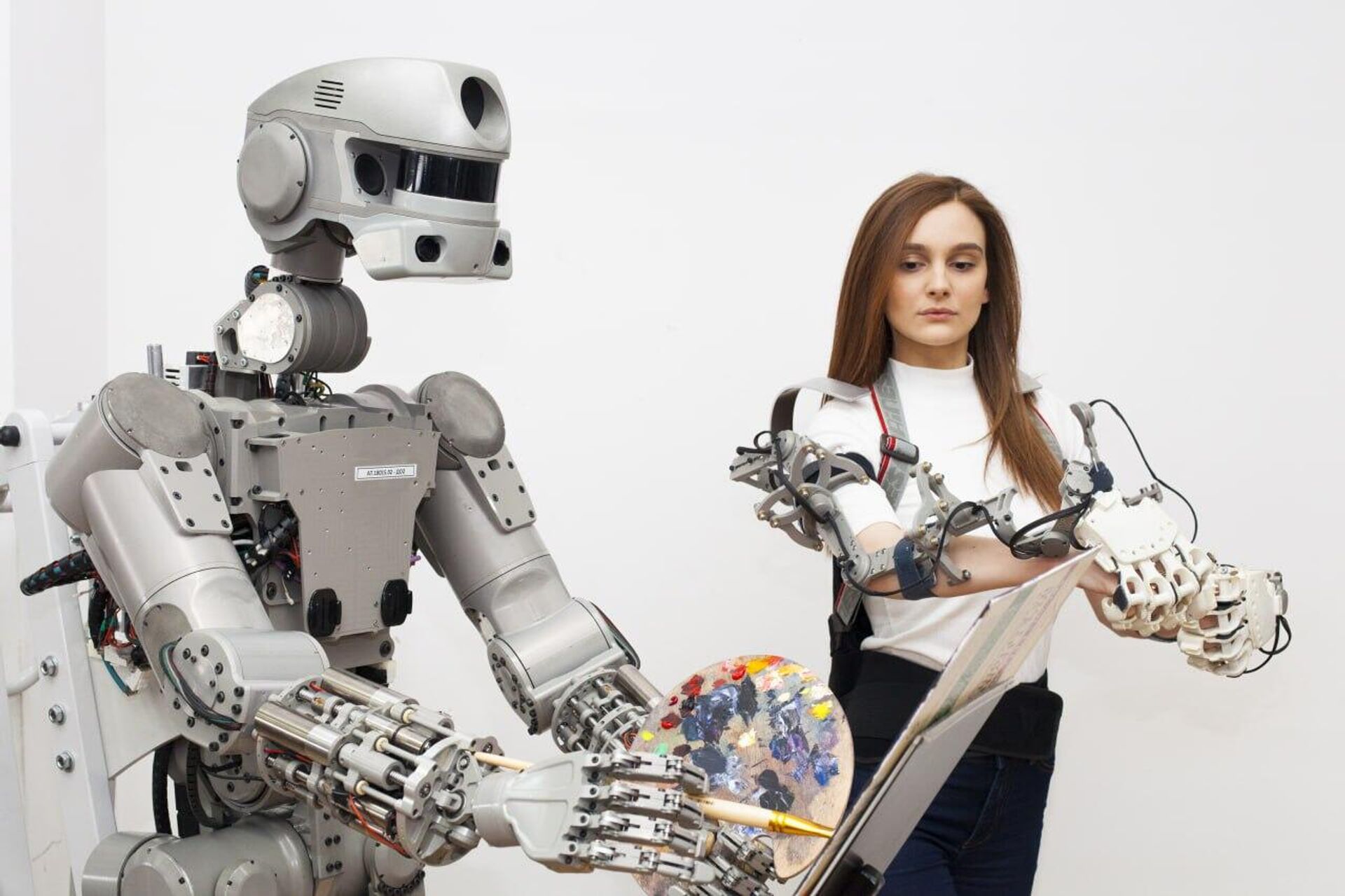
FEDOR (which stands for 'Final Experimental Demonstration Object Research') robot serving as an avatar to a human being.
© Sputnik / Androidnaya Tekhnika
Another prospective area of R&D mentioned by Dudorov is unmanned systems with high levels of artificial intelligence which could turn virtually any kind of vehicle into an unmanned one. The latter is a special challenge, according to the company official, because unlike computer program-based AI such as bank software, for example, robots need a highly complex series of additional adaptations to account for their interaction with the real, physical world.
“Because if we’re talking about a robot that has many different pedipulators, manipulators or ‘hands’ with grippers, that same robot must receive information from a person, receive information from the outside world; we give it commands, it must analyze these commands and, as a result of this analysis, refine results if necessary and, after clarification, execute these commands,” Dudorov said. “That is, there is a single block in which everything is tied into this system: technical vision, elements of sound perception, obtaining information, sound analysis; combining and transferring information to actuating devices (pedipulators or manipulators) to perform these actions is an extremely complex algorithm.”
In fact, Dudorov believes such algorithms are so complex that it is virtually impossible for human beings to create them without help from other AI.
Sanctions Challenges, Sanctions Opportunities
Asked to comment on the challenges Android Technics has faced as a result of Western sanctions, Dudorov noted that the company is actively working to chip away at restrictions, but that certain challenges remain. Citing the example of the company's work on FEDOR-2, successor to the FEDOR space-faring robot, he pointed out that "its components are almost 96 percent domestically sourced" at the moment.
"Nevertheless, the situation we're facing is known. There are sanctions, certain issues with the supply of components, but we are now promptly resolving these problems, and they do not significantly affect our project," Dudorov said.
Russian Robotics and the Future
Dudorov is confident that Russia can achieve autonomy and self-sufficiency in the sphere of robotics, but stressed that for this to happen, a number of steps would need to be taken, including financing credits and preferential loans, state subsidies, venture capital investment, etc.
Additionally, he said, a specialized state program in robotics is needed over the medium and long term, “which would reflect the interests of developers, those of consumers, and of course, of the state as such, because all of this is being done in the interests of the economic development of our country as a whole. Because robotics is a driver of economic development, and is an inter-sectoral industry which can create solutions for aircraft manufacturing, general civil engineering, the automotive industry, etc.”
“Companies engaged in the development of solutions and technologies in robotics must know what specific products they should develop, what they need to do,” Dudorov stressed, noting that such directives should help reduce needless duplication of work, saving both time and resources. Today, he said, such coordination is sorely lacking, and there is no separate ministry or department to engage in it.
Furthermore, Dudorov said, it’s necessary to ramp up the training of cadres, to expand robotics and AI systems education in schools. “We need to train the personnel who in 10-15 years will no longer be just ‘consumers’ of robotics, but work in companies which can become world leaders, world sovereign technology leaders. We must very actively train these personnel today already.”
More broadly, he said, Russia needs to ramp up investments in science, in technology, in fundamental technology, or be prepared to face the prospect of being unable to close the current technological “gap” with foreign competitors. “But something else is worth noting here: if we compare the costs of developing technologies in Russia compared to say the United States, we can do it for 10 times less than what’s being done there.”
Another key element is markets.
“As I see it, it’s normal for the state as a whole when it begins to produce some components to gain self-sufficiency. That is, to produce completely inside the country when its population reaches 250-300 million people…If there are fewer people, then, accordingly, a number of industries will be unprofitable, and will need to be subsidized one way or another. Here, of course, we need for the potential market to be no less than 300 million people. Plus, there must also be some friendly states with whom we could trade normally, and where we could deliver our solutions,” Dudorov summed up.
To date, Android Technics’ 150+ engineers have created over 120 robotic systems, published more than 50 scientific articles in major peer-reviewed journals, and amassed over 60 patents in the field.

